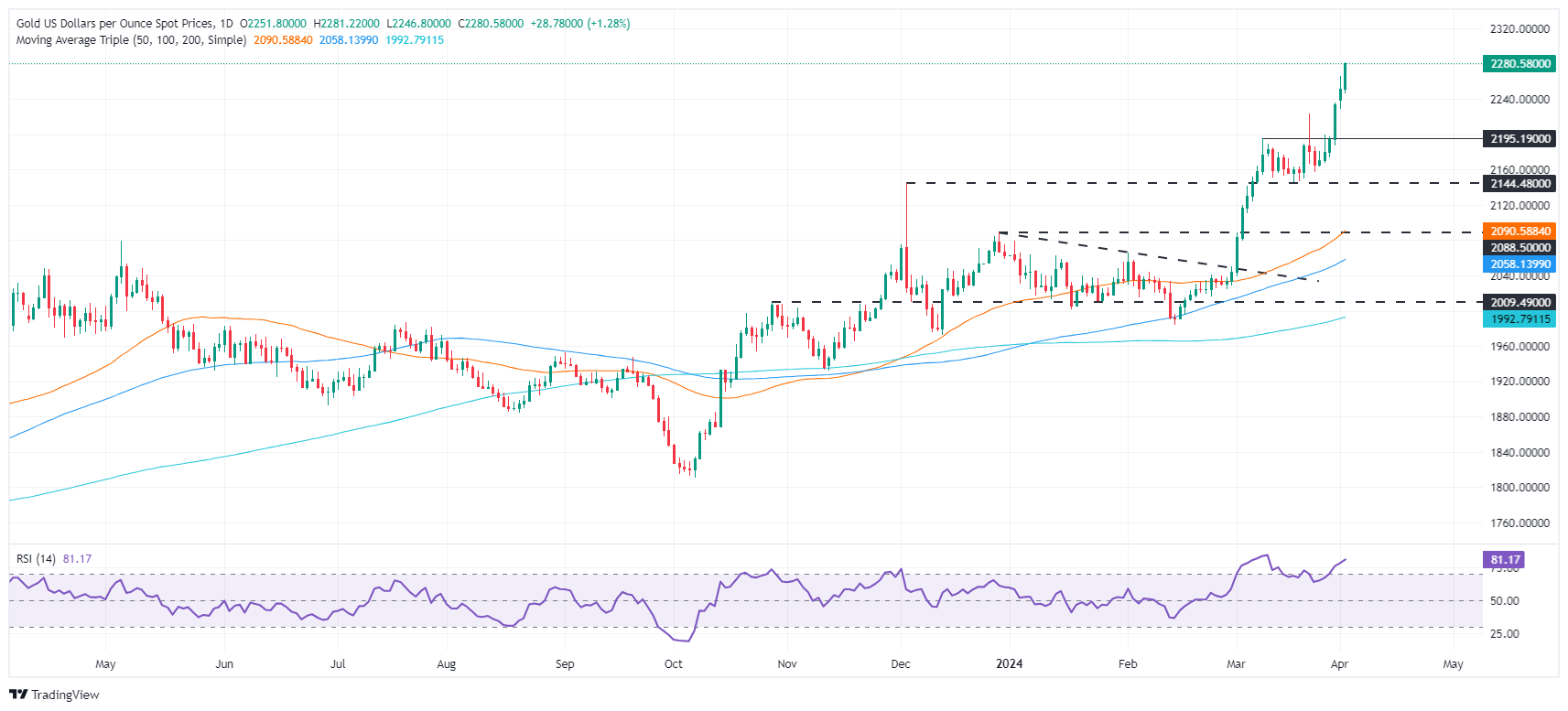Gold hits new peak amid rising middle East tensions, high US yields
- Gold climbs to $2,280, driven by Middle East tensions, strong US data.
- High US Treasury yields, strong US Dollar counterbalanced by geopolitical worries, tight labor market.
- Mester lacks info for a May rate cut but predicts three 2024 cuts, balancing inflation and job risks.
- Daly discussed rate duration, supports three rate cuts as a projection, not a promise.
Gold price rallies to new all-time highs of $2,276 late in the North American session amid geopolitical risks and despite higher US Treasury yields. Economic data from the United States (US) prompted investors a flight to safe-haven assets, sending the yellow metal higher. At the time of writing XAU/USD exchanges hands at $2,280 gaining more than 1%.
The recent attack of Israel against an Iran embassy in Syria on April 1, sponsored Gold’s leg up despite witnessing a jump in US yields and a strong US Dollar on Monday. Aside from this, the US Bureau of Labor Statistics (BLS) showed that job vacancies increased, revealing a tight labor market, while the US Census Bureau witnessed an improvement in Factory Orders.
In the meantime, Federal Reserve (Fed) officials crossed the newswires, led by the Cleveland Fed President Loretta Mester and the San Francisco Fed President Mary Daly.
Daily Digest Market Movers: Gold price ignores goodish US data, high US yields
- February’s Job Openings and Labor Turnover (JOLTS) summary revealed that job vacancies remained relatively stable. The figures reached 8.756 million, slightly above the previous month's revised total of 8.748 million and just surpassing the expected 8.75 million.
- Factory Orders in February experienced a growth of 1.4%, recovered from a -3.4% decline in January and exceeded the forecasts of a 1% increase.
- Cleveland Fed Loretta Mester said that she doesn’t have enough information for a May meeting cut, yet foresees three rate cuts in 2024. Mester added the Fed’s challenge would be balancing the risks between inflation and employment.
- San Francisco Fed President Mary Daly said the Fed need to see how long to keep rates at current levels. She supports three rate cuts, but added that it’s a projection, not a promise.
- On Friday, Fed Chair Jerome Powell responded to the latest inflation data, stating it aligned with their expectations and indicating that the Fed would not overreact to these figures. This suggests that the US central bank would remain in a wait-and-see approach toward future monetary policy decisions.
- In terms of the Federal Reserve's future interest rate movements, the CME FedWatch Tool indicates that traders currently assign a 58% likelihood to the prospect of the US central bank reducing borrowing costs.
Technical analysis: Gold rally extends, despite overbought RSI

The XAU/USD daily chart suggests the yellow metal is headed towards the $2,300 figure amid renewed buying pressures observed in the Relative Strength Index (RSI). On Monday, it was mentioned that “The XAU/USD daily chart depicts Gold's last uptick to new all-time highs, achieved on lower momentum, as depicted by the Relative Strength Index (RSI).” However, as of writing, the RSI has punched above the 80.00 threshold, an indications that buyers are in charge.
With price action at uncharted territory, the next resistance level would be the $2,300 mark, followed by the $2,350 psychological figure. Up next would be $2,400.
On the other hand, if XAU/USD drops below $2,250, that could sponsor a correction. The first support would be the $2,200 figure, followed by the March 8 high turned support at $2,195, ahead of extending its losses to $2,150.
Inflation FAQs
Inflation measures the rise in the price of a representative basket of goods and services. Headline inflation is usually expressed as a percentage change on a month-on-month (MoM) and year-on-year (YoY) basis. Core inflation excludes more volatile elements such as food and fuel which can fluctuate because of geopolitical and seasonal factors. Core inflation is the figure economists focus on and is the level targeted by central banks, which are mandated to keep inflation at a manageable level, usually around 2%.
The Consumer Price Index (CPI) measures the change in prices of a basket of goods and services over a period of time. It is usually expressed as a percentage change on a month-on-month (MoM) and year-on-year (YoY) basis. Core CPI is the figure targeted by central banks as it excludes volatile food and fuel inputs. When Core CPI rises above 2% it usually results in higher interest rates and vice versa when it falls below 2%. Since higher interest rates are positive for a currency, higher inflation usually results in a stronger currency. The opposite is true when inflation falls.
Although it may seem counter-intuitive, high inflation in a country pushes up the value of its currency and vice versa for lower inflation. This is because the central bank will normally raise interest rates to combat the higher inflation, which attract more global capital inflows from investors looking for a lucrative place to park their money.
Formerly, Gold was the asset investors turned to in times of high inflation because it preserved its value, and whilst investors will often still buy Gold for its safe-haven properties in times of extreme market turmoil, this is not the case most of the time. This is because when inflation is high, central banks will put up interest rates to combat it. Higher interest rates are negative for Gold because they increase the opportunity-cost of holding Gold vis-a-vis an interest-bearing asset or placing the money in a cash deposit account. On the flipside, lower inflation tends to be positive for Gold as it brings interest rates down, making the bright metal a more viable investment alternative.